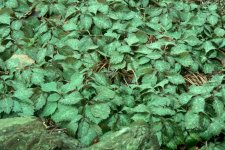
Click to enlarge
|
In many cases, I've discovered the Asian counterpart of
our native plants to
be much showier, more robust and in many instances more
floriferous than our
native species. Take Claytonia for example, our native
Claytonia virginica
and Claytonia caroliniana are very early,
beautiful little plants.
But, although their flowers are lovely, they're very small
and the entire plant
is extremely ephemeral. On the other hand,
Claytonia Sibirica has
thicker, more deeply veined foliage and flowers for
months.
One
major exception to this rule is Pachysandra
procumbens. P.p. is an
East Coast member of the Buxaceae (Boxwood) family and is
commonly referred to
as "Allegheny Spurge". It's superior to the more commonly
used (Asian)
Pachysandra terminalis in virtually every
respect.
The Asian
Pachysandra terminalis is a very aggressive,
stoloniferous thug in the
garden. And although this can be a benefit if you
want to fill in a
very large area, super fast, its well behaved
American cousin, P.
procumbens, is a clump forming groundcover that
fills in an area
slowy, but much more elegantly.
P.
procumbens is hardy in
most areas of the US, probably into zone 4, maybe even 3.
In zones 7-10 or
during mild Winters elsewhere, it stays evergreen. In
colder areas it will
be a herbaceous perennial.
In the early
Spring, P.p.
shoots up really cool spikes of pink and white fragrant
flowers that last for a
week or two. Soon after the flowers have set seed, the
first vegetative shoots
poke their heads through the soil and their dark green
leaves begin,to unfold.
In deep shade, the foliage remains a dark luxurious, green
all summer. The more
sun that the plants get, the lighter their leaves are. I
planted a row in full
sun as an experiment to test the plants extremes. The
plants in the sun
were healthy and productive but , the leaves were
paler in color, some
with an almost chloritic appearance. This is
definitely a dappled to deep
shade plant!
In the late summer to early fall,
P.p. reminds us of
the approaching Autumnal equinox by "opening its windows to
let in more light".
This effect takes its form as beautiful silvery mottling on
the leaves that I
can only compare to snowflakes in the respect that no two
leaves are alike. Oh
the joy of jumping around on the ground like a frog
from plant to plant,
trying to select the most striking patterns. In the end,
they're all brilliant
and unique.
P.p. is a very easy, but
slow plant to
propagate. You can take stem/leaf cuttings in the
early spring, but
rhizome divisions are quicker and easier. On a mature
rhizome, there many
"joints". If you make a complete cut at each joint,
leaving the plant
above it with a few good roots intact, you will have
several 2"-4" pieces
that you can pot up or lay out in a flat and cover with
about a 1/2" of soil.
Root pieces taken in the early spring, while the plants are
still dormant, will
produce new plants ready for planting the same
season.
All in all, it's
difficult to find a better, all around, more useful,
adaptable ground
cover plant than Pachysandra
procumbens.
If you're getting more
than one copy of this weekly mailing, or would like to
unsubscribe, or sign up a
friend, let me know.
|

